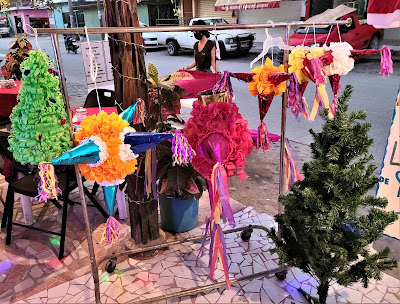It is a common plaint of Yankees who move to the American South -- or Arizona -- or southern California. The calendar rolls over to 25 December, and though it may look a lot like Christmas, it certainly does not feel that way.
Edward Kleban had the comparison correct in describing relationships that do not quite make it to love in "Next Best Thing to Love" -- "Something always missing/ Christmas in LA/ We could get to April/ Not to May."
Christmas in Mexico has that feel. Temperatures in the 80s. Humidity to match. 11 hours of daylight.
For all of that, there is no doubt The Look of Christmas is everywhere. I wandered around the local villages the last few days and gathered up some of those sights.
Mexico has its own Christmas culture. But the country has long been a cultural sponge. Whether by conquest, through immigrants, or appropriation from its neighbors, celebrations here are in constant flux.
The biggest change in Christmas customs arrived with Hernán Cortés and his Forced Assimilation Tribe in 1519. Obviously, there was no Christmas in Mexico prior to The Conquest, but the Catholic missionaries who accompanied him saw plenty of potential hostile takeovers, like turning the Aztec goddess Tonantzin into Our Lady of Guadalupe (who's your mama?).
But some of the current traditions were directly transplanted to Mexico from Catholic Europe. Such as, the crèche at the top of this essay -- awaiting the arrival of the Baby Jesus -- who will appear tomorrow.
What interested me more though was the odd combination of the tableau. The security cordon gives the impression that the anachronistic wise men, who have arrived two years too early, are lining up to use that chair to alleviate their anticipated break.
Both of the local squares have stylized Christmas trees. Here is San Patricio Melaque's.
This is Barra de Navidad's. Looking somewhat like an elf's cap.
What makes them interesting is that they are neither a Catholic or Mexican tradition.
Christmas trees are distinctly a Northern European pagan symbol adopted quite recently by German Protestants and more recently by the British through Prince Albert. The jump to America and the subsequent jump across the Rio Bravo was another example of cultural appropriation. And why not?
With the Christmas Tree came an American Christmas invention. Gene Autry's Frosty the Snowman, who holds court from the balcony of Barra's city hall.
Several years ago, Christmas parades were organized both in Melaque and Barra. The last two years, they have been cancelled out of fear that The Virus might find all the Christmas cheer far too enticing as a target.
But that has not stopped floats from spontaneously showing up on the streets of Barra de Navidad.
This multitude of Santas was a vehicle to toss rubber balls to children (and a few older citizens) on the sidewalks.
A few days earlier, what looked like a fellowship of Disney character refugees were tossing their own largesse around.
And Christmas would not be complete without Christmas wares spilling out onto the sidewalk from local shops.
A couple of years ago, the owners of sailboats that anchor at the marina across the laguna from Barra de Navidad banded together to transplant a tradition dear to the hearts of northern mariners -- a Christmas boat parade. I wrote about it last year in 'tis the season to be silly.
This year's parade brought the same chuckles. Anything that can be as witty to elicit smiles and laughter is something to be praised. Unfortunately, I forgot my SDLR. But the shoddy quality of the photographs does not lessen the joy the boats brought to us landlubbers.
But some Mexican Christmas traditions did not need Northern European or American contributions. Like these piñatas. Whacking a Martin Luther-inspired Christmas tree piñata would undoubtedly bring a smile to the pope. And Mexico likes making popes happy.
Piñatas, though, are not just for Christmas. Posadas are. Though posadas are conducted throughout Latin America, Mexico has made the tradition its own.
From 16 to 24 December, groups of the devout re-enact Joseph and Mary's attempt to find room in any inn to give birth to the Baby Jesus. There is singing and joy when the young couple are finally admitted -- admittedly to a stable. But they find some comfort.
Several nights ago, I drove past a group of youngsters out on their posada. The young man playing Joseph had added a rather startling accessory to his outfit. He was carrying the Baby Jesus prior to the manger scene.
But why not? If the posada can honor the pregnant Mary and the unborn Baby Jesus, why not the born Baby Jesus? After all, it is well-accepted that the gospels attributed to Luke and Matthew are fact-short and truth-full. Why not tell that truth with another twist?
It made me smile. But so did the floats, the wise men waiting room, the shoppers, the Protestant Christmas paraphernalia, the festive-lit sailboats, and the piñatas.
I am not a big fan of Christmas, but if anything can cause me to smile and laugh out loud as these last few days have done cannot be all that bad.
Even if it feels we should all be spending our afternoons at the beach.
Note -- Like the young man who improvised his Joseph role, I would like to share a Christmas song that means something to me.










No comments:
Post a Comment